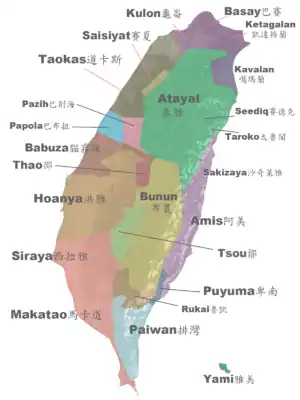
The Bible translations into the languages of Taiwan are into Taiwanese, Hakka, Amis, and other languages of Taiwan.
Mandarin Chinese
In Taiwan, education from kindergarten to college is done in Mandarin Chinese (Chinese: 國語). Chinese is used in government offices and large corporations. The Bible text in Mandarin Chinese is in Traditional Chinese, written vertically, rather than in Simplified Chinese, written horizontally.
Taiwanese
The majority of the Taiwan people speak at home Taiwanese, sometimes called Taiwanese Hokkien or Min Nan Yu (Chinese: 閩南語) because their ancestors came from the southern part of China's Fujian Province. In 1916, Thomas Barclay finished the New Testament translation into Taiwanese Hokkien, followed by the Old Testament translation using Latin script in 1930. He carried out the translation with Chinese assistants in Xiamen, Fujian. His entire NT/OT Bible, now called Amoy Romanized Bible (Chinese: 廈語羅馬字聖經, Amoy was the English name for Xiamen), was published in Shanghai in 1933.[1] The copies of this translation was once confiscated by the Taiwan Garrison Command during the martial law era for "obstructing of the Kuo-yu policy". In 1996, this Bible was put into the Chinese characters, called Taiwanese Han Character Bible (Chinese: 台語漢字本聖經).[2][3]
| Translation | John John 3:16 |
|---|---|
| Taiwanese Bible Romanized Character Edition.[4] | In-ūi Siōng-tè chiong to̍k-siⁿ ê Kiáⁿ siúⁿ-sù sè-kan, hō͘ kìⁿ-nā sìn I ê lâng bōe tîm-lûn, ōe tit-tio̍h éng-oa̍h; I thiàⁿ sè-kan kàu án-ni. |
| Taiwanese Bible Han Character Edition.[5] | 因為上帝將獨生的子賞賜世間,互見若信伊的人,[勿會]沈淪,會得著永活,伊疼世間到按呢。 |
The translation of Taiwanese Bible: Today's Taiwanese Version using Latin and Han script is already complete for the New Testament with Psalms and Proverbs, the remaining books of Old Testament are under going translation.[6] The revision was completed at late 2021.
Hakka
The Hakka people live mainly in Taiwan's northwest areas, such as Taoyuan City, Hsinchu County and Miaoli County. The Hakka language is one of the four languages (the other three being Mandarin Chinese, Taiwanese and English) heard in the public transportation announcement in Taipei. Bible translation into Hakka language started in 1984. In 1993, the New Testament with the Psalms in Hakka was published, followed by the publication in 2012 of Hakka Bible: Today's Taiwan Hakka Version.[7]
Amis
The Amis people, living in Taiwan's east coast (Hualien, Taitung County and Pintung Counties), are the largest group among the Taiwanese indigenous peoples. In 1957, the Book of John was translated into Amis language using Bopomofo. After 1963, translation proceeded using Pinyin, and the New and Old Testaments in Amis were published in 1997.[8] A revised version of New Testament with Psalms and Proverbs was published in 2019.
Other languages
The Bible translations into other languages of Taiwan are done or being done: Paiwan language (New Testament/part of OT in 1993), Bunun language (NT in 1983; part of Old Testament in 2000), Atayal language (NT using Bopomofo in 1974; Romanized NT/part of OT in 2003; Complete Romanized text in 2022), Truku language (NT in 1960; NT/OT in 2005), Tao/Yami Language (NT in 1994; OT in progress), Rukai (NT in 2001; NT/OT in 2017), Tsou language (NT in 2013; OT in progress), Seediq language (NT/OT in 2020).
See also
References
- ↑ "白話字聖經的由來" [The origin of the Bible in Pe̍h-ōe-jī]. The Bible Society in Taiwan (in Chinese).
- ↑ 行過幽谷的《台語漢字本聖經》 (中文)
- ↑ 巴克禮台語漢字本繁體聖經 The Taiwanese Bible: Barkclay Revised Version Han Character Edition (Traditional Chinese)
- ↑ "Taiwanese Bible Romanized Character Edition". Archived from the original on 2020-06-27. Retrieved 2022-07-17.
- ↑ Taiwanese Bible Han Character Edition
- ↑ The Taiwanese language Bible (Taiwan Bible Society) (in Chinese)
- ↑ The Hakka language Bible (Taiwan Bible Society) (in Chinese)
- ↑ The Amis language Bible (Taiwan Bible Society) (in Chinese)
External links
- Bible Society of Taiwan (in Chinese)
- Chinese and Taiwanese Bibles (Bible Society in Japanese) (in Japanese)